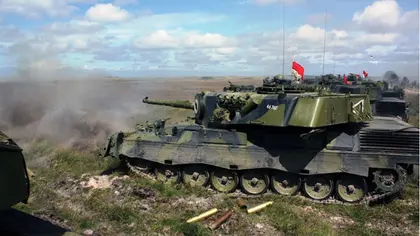A Copenhagen-led three-nation coalition plans to send Leopard 1 tanks to Ukraine, Danish and Ukrainian officials have confirmed. While the weapon was developed in the 1960s, the Leopard 1 is still combat-capable thanks to extensive upgrades, and it is hoped that the tanks will arrive in time to support Kyiv’s long-awaited counter-offensive.
Acting Danish Defense Minister Troels Lund Poulsen at a joint briefing with Ukrainian Defence Minister Oleksii Reznikov on Monday, April 10, said: "We hope that we will start supplying tanks by the summer. Looking six months ahead, it will be possible to deliver about 100 Leopard 1 tanks to Ukraine."
- View the most recent Ukraine news pieces that came out today.
- Russian Losses
JOIN US ON TELEGRAM
Follow our coverage of the war on the @Kyivpost_official.
A NATO-standard main battle tank mostly fielded from the 1970s to the 1990s, the German-developed Kampfpanzer Leopard 1 is the older cousin of Rheinmettal’s top-of-the-line Leopard 2 tank.
Armored more heavily than all Russian tanks operating in Ukraine, and equipped with state-of-the art fire control, troop protection, sensor systems, and a powerful 120mm cannon, the Leopard 2 is widely used by European and other militaries. Crew members say a Leopard 2 can hit a moving vehicle at ranges of three kilometers – roughly twice the accuracy of even Russia’s best tanks.
Germany, Poland, Portugal, Canada, Norway, Spain and Sweden have promised to send Ukraine at least 71 Leopard 2 tanks. It is estimated that roughly half of the promised Leopard 2s had actually reached Kyiv’s forces by April 11, the independent Ukraine war monitor Oryx reported.

Trump Makes 90 Day Foreign Aid Freeze – Ukraine Military Support Supposedly Untouched
Denmark, Germany and the Netherlands have limited numbers of Leopard 2 to give to Ukraine, so they are moving ahead with plans to fill that gap with Leopard 1A5 tanks taken from long-term storage, Poulsen said.
According to Danish military media reports, Ukraine will receive the Leopard 1A5DK, a weapon operated by Danish Army peacekeepers in Croatia and Bosnia in the 1990s, and in regular forces until the mid-2000s. Copenhagen-purchased upgrades for the vehicle include a new diesel engine, advanced gun stabilization, modernized fire control and sensor systems, bolt-on polycarbonate armor, and enhanced crew protection.
Compared with Leopard 2, the Leopard 1 has a smaller cannon and weaker armor, but comparable fire control and gun accuracy. A Ukrainian crew operating the older Leopard should be able to shoot first, hit, and destroy almost all current Russian armored vehicles, at any range. The exception would be a rare face-to-face engagement against late-model Russian tanks, whose thick frontal armor the Leopard I’s main gun might not always penetrate, military observers said.
According to the Danish online news platform OLFI, in February a German company called Flensburger Farhzeugbau Gesellschaft was holding 99 Leopard 1A5 tanks in a depot across the border from Denmark, as reserve vehicles for the Danish Army. According to a February 7 article, in the Danish mainstream newspaper Jyllands-Posten, Denmark, Germany and Netherlands will coordinate and finance the repair and transfer of at least 80 tanks to Ukraine.
The vehicles were in long-term storage and needed repair and maintenance before being serviceable for combat, but, they did not require upgrading and “Ukraine is screaming for tanks,” OLFI wrote in a February 1 article.
An initial 20-tank batch of 20 of the Leopard tanks would be ready for shipment to Ukraine “in a few months,” to be followed by more deliveries as additional vehicles were returned to operational status, the OLFI report said.
Other Danish media reported Ukrainian troops should begin receiving the tanks by the end of April – theoretically in time for Ukraine’s long-awaited Spring offensive.
The recent leak of a late February US military intelligence briefing on Ukraine’s offensive preparations, listed 53 tanks of unnamed type set to enter the Ukrainian military with delivery dates at the end of March, April and “unknown”. The same briefing slide said 32 Leopard 2 tanks (from Germany, Canada and Poland) would be in Armed Forces of Ukraine hands by the end of April.
It is not clear whether crew training for the Danish Leopard 1A5s is already in progress, or would take place after Ukraine received the vehicles. Past training of Ukrainian tank crews for Leopard 2 has taken around two months.
Poulsen at the Monday press conference said it was “important that Ukrainian specialists have the opportunity to service and repair these weapons (Leopard 1) before they arrive in Ukraine… and (that) this question will be worked on.”
In the summer of 2022, executives of the German company Rheinmetall offered to sell 88 Leopard 1 tanks, held in company storage, to anyone who would buy them, for transfer to the Ukrainian military. Berlin officials cold-shouldered the idea for months citing concerns that sending the 30-year-old tanks to Ukraine, for defensive purposes, might make Russia aggressive.
By early 2023 the German government had largely reversed its position on weapons to Ukraine, but without moving to rapid or large-scale deliveries. Defense Minister Boris Pistorius in a March interview ,with die Welt newspaper, said Berlin’s medium-term intention is for the Ukrainian army to receive 100 Leopard 1 tanks “by the end of the year”.
On March 10, Ukrainian Defense Minister Oleksiy Reznikov said “looking six months ahead” he expected “about 100 Leopard 1 tanks” would have arrived in Ukraine.
You can also highlight the text and press Ctrl + Enter










